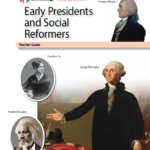This unit provides lesson plans to help teachers cultivate respectful and constructive discussions among students in the classroom, promoting critical thinking, empathy, and effective communication skills.
Heroes of Progress
This unit focuses on the remarkable historical figures who have embodied human progress and innovation throughout world history. Students will delve into the lives and achievements of influential individuals, exploring their contributions in areas such as science, art, and social reform, cultivating a deep appreciation for the transformative power of individuals in shaping our world.
Foundations of Civics and Economics
This unit on civics fosters critical thinking skills in students as they engage with topics in government, democracy, and U.S. history, providing comprehensive lesson plans that encourage deep analysis, evaluation, and reflection on the principles and dynamics of civic life.
Article V and the 27 Amendments – Module 15 of Constitution 101
With the Constitution, the Founding generation created the greatest charter of freedom in the history of the world. However, the Founding generation did not believe that it had a monopoly on constitutional wisdom. Therefore, the founders set out a formal amendment process that allowed later generations to revise our nation’s charter and “form a more perfect Union.” They wrote this process into Article V of the Constitution. Over time, the American people have used this amendment process to transform the Constitution by adding a Bill of Rights, abolishing slavery, promising freedom and equality, and extending the right to vote to women and African Americans. All told, we have ratified 27 constitutional amendments across American history. Learning objectives: Describe the reasons that the Founding generation included a formal process for amending the Constitution;
explain how the Constitution’s amendment process works, and why the founders made it so hard to amend the Constitution; identify the key periods of constitutional change in American history and outline factors that drive successful pushes to amend the Constitution; describe all 27 amendments to the U.S. Constitution.
Bell Ringer: How Electoral Votes Are Counted
Brookings Institution Governance Studies Senior Fellow Molly Reynolds talks about the Electoral Count Act of 1887, the current law for how electoral votes get counted after a presidential election. She explains reform efforts and the role of the vice president of the U.S. in the electoral count.
The Election of 1824-25: When the House Chose the President
In 1804, the 12th Amendment was passed to require separate balloting for president and vice president. In spite of the 12th Amendment, deadlocks can occur. Such was the case in the election of 1824, and the House of Representatives once again was forced to choose.
The Troubled Elections of 1796 and 1800
George Washington won the first two U.S. presidential elections without being challenged. When he decided not to run for a third term in 1796, intense rivalries, political disputes, and attempted manipulations of the Electoral College came into play. These factors would again affect the 1800 election, essentially a rematch of 1796, pitting a sitting president, John Adams, against his own vice president, Thomas Jefferson.
Constitution Clips
C-SPAN’s Constitution Clips makes the U.S. Constitution come alive by providing teachers and students with video clips from C-SPAN’s Video Library of the Constitution in action.
Early Presidents (CKHG Unit)

This unit (first half of Early Presidents and Social Reformers) focuses on the first seven presidents of the United States. Across 9 lessons, students learn about how the early presidents organized the federal government, built a national capital, directed a second war with Great Britain, more than doubled the size of the country, and formulated a “hands-off” foreign policy in the Western Hemisphere.
The Constitution in Action – Political Parties and Presidential Electors: The Election of 1800
History is the chronicle of choices made by actors/agents/protagonists in specific contexts. This simulation places students in the Early Republic and asks them to engage in the politics of those times. Acting as either Federalists or Republicans, they will be asked to develop strategies for electing their party’s standard bearer as president, using the Constitution’s complex system of presidential electors to their advantage.